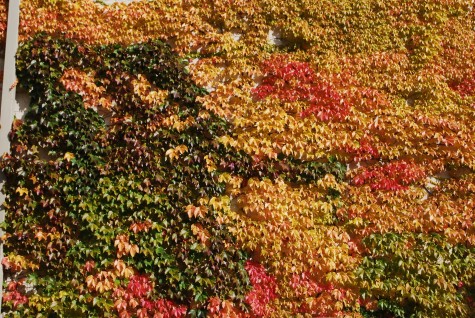 I have never forgotten my ninth grade science teacher, Dr. Watson. He concluded every lecture or discussion with the statement, “And that is the beauty of science”. Though at the time I thought he was a crackpot, I now know he was absolutely right. Today I am thinking about Parthenocissus Tricuspidata; Boston Ivy is an ordinary plant with a fancy scientific name whose primary claim to fame is its ability to grip to and cover walls with dense sheets of leaves. Why today? The fall color of Boston Ivy is one of nature’s most spectacularly glowing moments, ranking right up there with the aurora borealis.
I have never forgotten my ninth grade science teacher, Dr. Watson. He concluded every lecture or discussion with the statement, “And that is the beauty of science”. Though at the time I thought he was a crackpot, I now know he was absolutely right. Today I am thinking about Parthenocissus Tricuspidata; Boston Ivy is an ordinary plant with a fancy scientific name whose primary claim to fame is its ability to grip to and cover walls with dense sheets of leaves. Why today? The fall color of Boston Ivy is one of nature’s most spectacularly glowing moments, ranking right up there with the aurora borealis.
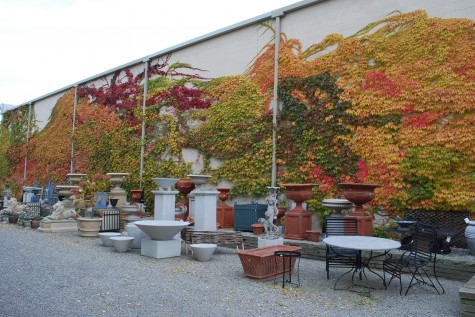 One wall of the building next door to me sits right on my property line; that would be just about two thousand square feet of beige concrete block. Needless to say, I was not too crazy about the look. Five Boston Ivy plants have just about transformed that wall in four years time; today it is looking exceptionally good. The science behind all this color-the formation of the abcission layer. Don’t black out; I’m talking about the beauty of science here. As soon as the nights get long enough in the fall, the cells that connect the leaves to the stems begin to rapidly divide-but they do not expand. This produces a brittle callus, which slows, and finally prevents the flow of nutrients from the stem to the leaves. The plant is going dormant, and putting any expenditure of energy on hold. This is a survival mechanism, the instinct to preserve life, and the beauty of science.
One wall of the building next door to me sits right on my property line; that would be just about two thousand square feet of beige concrete block. Needless to say, I was not too crazy about the look. Five Boston Ivy plants have just about transformed that wall in four years time; today it is looking exceptionally good. The science behind all this color-the formation of the abcission layer. Don’t black out; I’m talking about the beauty of science here. As soon as the nights get long enough in the fall, the cells that connect the leaves to the stems begin to rapidly divide-but they do not expand. This produces a brittle callus, which slows, and finally prevents the flow of nutrients from the stem to the leaves. The plant is going dormant, and putting any expenditure of energy on hold. This is a survival mechanism, the instinct to preserve life, and the beauty of science.
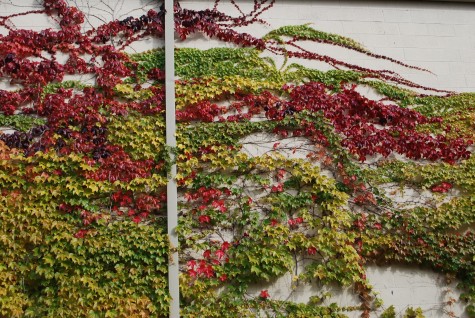 At the same time, the leaves slow down and eventually quit producing chlorophyll-that chemical that makes leaves green. If chlorophyll is not constantly manufactured in a leaf, the leaf will fade in sunlight. Chlorophyll masks the other pigments existing in leaves; the yellows, oranges and reds that were there all along are revealed when the production of chlorophyll ceases.
At the same time, the leaves slow down and eventually quit producing chlorophyll-that chemical that makes leaves green. If chlorophyll is not constantly manufactured in a leaf, the leaf will fade in sunlight. Chlorophyll masks the other pigments existing in leaves; the yellows, oranges and reds that were there all along are revealed when the production of chlorophyll ceases.
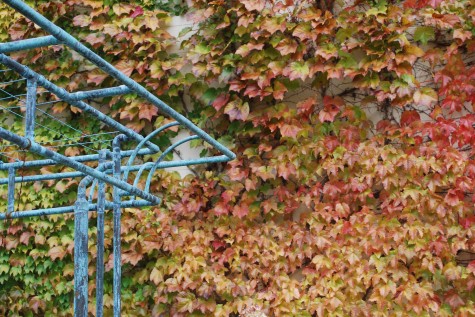 Though day length triggers this process, the temperatures, the moisture in the soil, and sunlight influence the overall show. A dry growing season can encourage leaves to drop early before they reveal any color. High winds can sever the dry corky abscission layer with the same result. At any rate, the variation and intensity of color on this wall is different every year given weather conditions. I can see that light, water, wind, sun and overnight temperatures affect the leaves on wall at different rates.
Though day length triggers this process, the temperatures, the moisture in the soil, and sunlight influence the overall show. A dry growing season can encourage leaves to drop early before they reveal any color. High winds can sever the dry corky abscission layer with the same result. At any rate, the variation and intensity of color on this wall is different every year given weather conditions. I can see that light, water, wind, sun and overnight temperatures affect the leaves on wall at different rates.
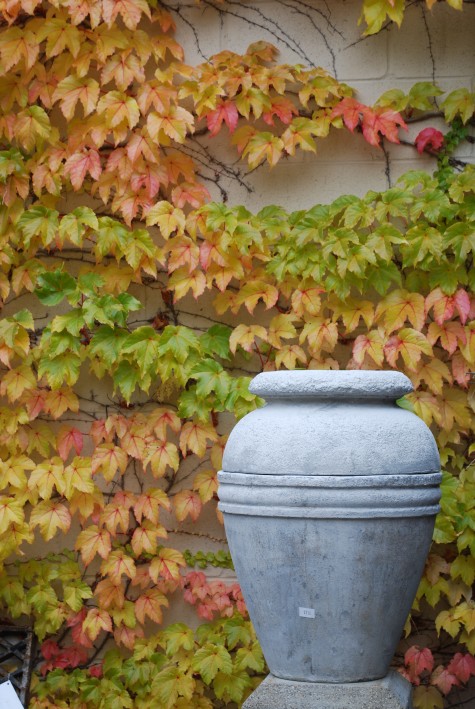 It is easy to see the chlorophyll fading at different rates in different leaves-the color variation within each individual leaf is beautiful.
It is easy to see the chlorophyll fading at different rates in different leaves-the color variation within each individual leaf is beautiful.
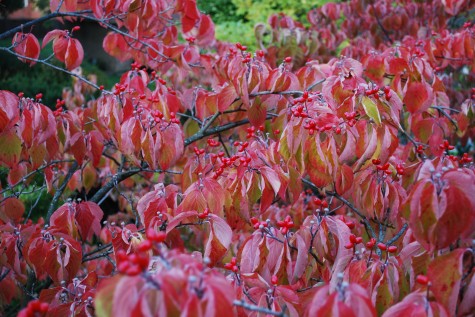 Anthocyanins are responsible for the red and purple pigments in leaves. They are manufactured from sugars that are trapped in the leaf. Oddly enough, these pigments are not present in leaves during the growing season. The role of these pigments is not so well understood. If you are interested in reading more about it, The United States National Arboretum has an excellent article on line about the science of color in autumn leaves.
Anthocyanins are responsible for the red and purple pigments in leaves. They are manufactured from sugars that are trapped in the leaf. Oddly enough, these pigments are not present in leaves during the growing season. The role of these pigments is not so well understood. If you are interested in reading more about it, The United States National Arboretum has an excellent article on line about the science of color in autumn leaves.
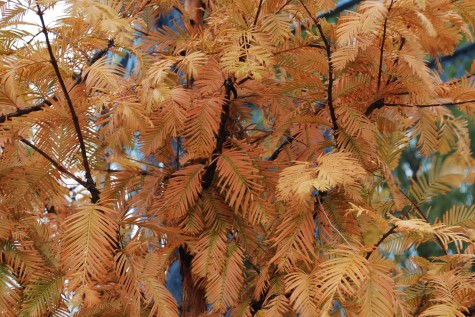 Metasequoia Glyptostroboides-I wish this were my name. The Dawn Redwood is an ancient evergreen tree with a twist; it drops its needles in the fall, after turning this glorious peachy orange. This deciduous evergreen is an anomaly amongst evergreens, which ordinarily hold their foliage all winter.
Metasequoia Glyptostroboides-I wish this were my name. The Dawn Redwood is an ancient evergreen tree with a twist; it drops its needles in the fall, after turning this glorious peachy orange. This deciduous evergreen is an anomaly amongst evergreens, which ordinarily hold their foliage all winter.
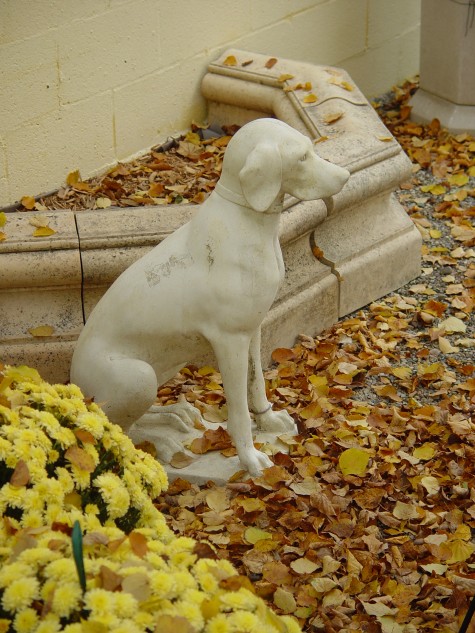
The brilliant colors of fall leaves holds but a very short time. These pigments break down when exposed to light, or heavy frost. The brown color you see in these leaves is a result of the only pigment left-the tannins. The story of parthenocissus is not only about the beauty of science. It is just as much the story of the miracle that is nature.
WOW! Very interesting!
We don’t have the color change here, at least not on the scale that it happens for you. I would love to have that wall to look at outside my window!
Great post!
An excellent post, with useful and easy-to-grasp info. And that wall! Talk about vertical gardening; it’s living artwork. I love the colours of Boston ivy and even of its less well-behaved cousin Virginia creeper.
That is THE MOST GORGEOUS wall of parthenocissus I’ve ever seen! WOW! You know, with all the hype over green walls, I wonder “where have people been?” We already HAVE green walls – VINES!!!
You illustrated that perfectly! Thanks for the beauty!
Beautiful pics. I thought the vine was a vertical garden at first. Interesting and thought provoking post. Why do the leaves change colours at different rates, do all leaves have exactly the same function?
OK, my favorite two plant names – Chamaecyparus pisifera filifera aurea AND Metasequoia glyptostroboides! I thought I was the only plant name geek. 😉